Comparative Analysis of the Global Forest/Non-Forest Maps Derived from SAR and Optical Sensors. Case Studies from Brazilian Amazon and Cerrado Biomes
Abstract
1. Introduction
2. Materials and Methods
2.1. Study Areas
2.2. Data Sets
2.3. Methodological Approach
3. Results and Discussion
3.1. Amazon Biome
3.2. Cerrado Biome
4. Conclusions
Supplementary Materials
Author Contributions
Funding
Institutional Review Board Statement
Informed Consent Statement
Data Availability Statement
Acknowledgments
Conflicts of Interest
References
- FAO. Global Forest Resources Assessment 2020. Key Findings; FAO: Rome, Italy, 2020; 16p. [Google Scholar]
- FAO. Global Forest Resources Assessment 2015, 2nd ed.; FAO: Rome, Italy, 2016; 54p. [Google Scholar]
- Shimada, M.; Itoh, T.; Motooka, T.; Watanabe, M.; Shiraishi, T.; Thapa, R.; Lucas, R. New global forest/non-forest maps from ALOS PALSAR data (2007–2010). Remote Sens. Environ. 2014, 155, 13–31. [Google Scholar] [CrossRef]
- Pendrill, F.; Persson, U.M.; Godar, J.; Kastner, T.; Moran, D.; Schmidt, S.; Wood, R. Agricultural and forestry trade drives large share of tropical deforestation emissions. Glob. Environ. Chang. 2019, 56, 1–10. [Google Scholar] [CrossRef]
- Batistella, M.; Robeson, S.; Moran, E.F. Settlement design, forest fragmentation, and landscape change in Rondônia, Amazônia. Photogramm. Eng. Remote Sens. 2003, 69, 805–812. [Google Scholar] [CrossRef]
- Siqueira-Gay, J.; Sonter, L.J.; Sánchez, L.E. Exploring potential impacts of mining on forest loss and fragmentation within a biodiverse region of Brazil’s northeastern Amazon. Resour. Policy 2020, 67, 101662. [Google Scholar] [CrossRef]
- Southworth, J.; Marsik, M.; Qiu, Y.; Perz, S.; Cumming, G.; Stevens, F.; Rocha, K.; Duchelle, A.; Barnes, G. Roads as drivers of change: Trajectories across the tri-national frontier in MAP, the southwestern Amazon. Remote Sens. 2011, 3, 1047–1066. [Google Scholar] [CrossRef]
- Foley, J.A.; DeFries, R.; Asner, G.P.; Barford, C.; Bonan, G.; Carpenter, S.R.; Chapin, F.S.; Coe, M.T.; Daily, G.C.; Gibbs, H.K.; et al. Global consequences of land use. Science 2005, 309, 570–574. [Google Scholar] [CrossRef]
- Barlow, J.; Lennox, G.D.; Ferreira, J.; Berenguer, E.; Lees, A.C.; Mac Nally, R.; Thomson, J.R.; Ferraz, S.F.D.B.; Louzada, J.N.; Oliveira, V.H.F.; et al. Anthropogenic disturbance in tropical forests can double biodiversity loss from deforestation. Nature 2016, 535, 144–147. [Google Scholar] [CrossRef]
- Zemp, D.C.; Schleussner, C.F.; Barbosa, H.M.J.; Rammig, A. Deforestation effects on Amazon forest resilience. Geophys. Res. Lett. 2017, 44, 6182–6190. [Google Scholar] [CrossRef]
- Spracklen, D.V.; Arnold, S.R.; Taylor, C.M. Observations of increased tropical rainfall preceded by air passage over forests. Nature 2012, 489, 282–285. [Google Scholar] [CrossRef]
- Hansen, M.C.; Potapov, P.V.; Moore, R.; Hancher, M.; Turubanova, S.A.; Tyukavina, A.; Thau, D.; Stehman, S.V.; Goetz, S.J.; Loveland, T.R.; et al. High-resolution global maps of 21st-century forest cover change. Science 2013, 342, 850–853. [Google Scholar] [CrossRef]
- JAXA. JICA-JAXA Forest Early Warning System in the Tropics. 2020. Available online: https://www.eorc.jaxa.jp/jjfast/ (accessed on 28 March 2020).
- INPE. TerraBrasilis. PRODES (Deforestation). Available online: http://terrabrasilis.dpi.inpe.br/app/map/deforestation?hl=pt-br (accessed on 28 March 2020).
- Sano, E.E.; Rosa, R.; Brito, J.L.S.; Ferreira, L.G. Land cover mapping of the tropical savanna region in Brazil. Environ. Monit. Assess. 2010, 166, 113–124. [Google Scholar] [CrossRef] [PubMed]
- Martone, M.; Rizzoli, P.; Wecklich, C.; González, C.; Bueso-Bello, J.L.; Valdo, P.; Schulze, D.; Zink, M.; Krieger, G.; Moreira, A. The global forest/non-forest map from TanDEM-X interferometric SAR data. Remote Sens. Environ. 2018, 205, 352–373. [Google Scholar] [CrossRef]
- Lewis, A.J.; Henderson, F.M.; Holcomb, D.W. Radar fundamentals. The geoscience perspective. In Manual of Remote Sensing. Principles and Applications of Imaging Radar. v. 2, 3rd ed.; Henderson, F.M., Lewis, A.J., Eds.; John Wiley & Sons: New York, NY, USA, 1998; pp. 131–181. [Google Scholar]
- Koyama, C.N.; Watanabe, M.; Hayashi, M.; Ogawa, T.; Shimada, M. Mapping the spatial-temporal variability of tropical forests by ALOS-2 L-band SAR big data analysis. Remote Sens. Environ. 2019, 233, 111372. [Google Scholar] [CrossRef]
- Chazdon, R.L.; Brancalion, H.S.; Laestadius, L.; Bennett-Curry, A.; Buckingham, K.; Kumar, C.; Moll-Rocek, J.; Vieira, I.C.G.; Wilson, S.J. When is a forest a forest? Forest concepts and definitions in the era of forest and landscape restoration. Ambio 2016, 45, 538–550. [Google Scholar] [CrossRef]
- UNFCCC. Report of the Conference of the Parties on its Seventh Session, 2002 (FCCC/CP/2001/13/Add.1, UNFCCC, Marrakesh, Morocco, 2001). Available online: http://unfccc.int/resource/docs/cop7/13a01.pdf (accessed on 11 September 2019).
- FAO. Global Forest Resources Assessment 2010. Terms and Definitions; FAO: Rome, Italy, 2010; 27p. [Google Scholar]
- Congalton, R.G.; Gu, J.; Yadav, K.; Thenkabail, P.; Ozdogan, M. Global land cover mapping: A review and uncertainty analysis. Remote Sens. 2014, 6, 12070–12093. [Google Scholar] [CrossRef]
- Koyama, C.N.; Watanabe, M.; Sano, E.; Nagatani, I.; Hayashi, M.; Tadono, T.; Shimada, M. On the challenges for operational deforestation detection in a pantropical L-band SAR early warning system—Understanding the stability of radar backscatter over tropical forest. Remote Sens. Ecol. Conserv. 2020. submitted, under review. [Google Scholar]
- Olofsson, P.; Foody, G.M.; Herold, M.; Stehman, S.V.; Woodcock, C.E.; Wulder, M.A. Good practices for estimating area and assessing accuracy of land change. Remote Sens. Environ. 2014, 148, 42–57. [Google Scholar] [CrossRef]
- IBGE. Manual Técnico da Vegetação Brasileira; IBGE: Rio de Janeiro, Brazil, 2012; 271p.
- Carvalho, W.; Mustin, K. The highly threatened and little-known Amazonian savannahs. Nat. Ecol. Evol. 2017, 1, 0100. [Google Scholar] [CrossRef]
- IBGE. Mapa de Biomas e de Vegetação; IBGE: Rio de Janeiro, Brazil, 2004. Available online: https://ww2.ibge.gov.br/home/presidencia/noticias/21052004biomashtml.shtm (accessed on 10 March 2020).
- Soares-Filho, B.; Rajão, R.; Macedo, M.; Carneiro, A.; Costa, W.; Coe, M.; Rodrigues, H.; Alencar, A. Cracking Brazil´s forest code. Science 2014, 344, 363–364. [Google Scholar] [CrossRef]
- Myers, N.; Mittermeier, R.A.; Mittermeier, C.G.; Fonseca, G.A.B.; Kent, J. Biodiversity hotspots for conservation priorities. Nature 2000, 403, 853–858. [Google Scholar] [CrossRef]
- Ratter, J.A.; Ribeiro, J.F.; Bridgewater, S. The Brazilian Cerrado vegetation and threats to its biodiversity. Ann. Bot. 1997, 80, 223–230. [Google Scholar] [CrossRef]
- Joly, C.A.; Padgurschi, M.C.G.; Pires, A.P.F.; Agostinho, A.A.; Marques, A.C.; Amaral, A.G.; Cervone, C.O.F.O.; Adams, C.; Baccaro, F.B.; Sparovek, G.; et al. Apresentando o diagnóstico brasileiro de biodiversidade e serviços ecossistêmicos. In Diagnóstico Brasileiro de Biodiversidade e Serviços Ecossistêmicos; Joly, C.A., Scarano, F.R., Seixas, C.S., Metzger, J.P., Ometto, J.P., Bustamante, M.M.C., Padgurschi, M.C.G., Pires, A.P.F., Castro, P.F.D., Gadda, T., et al., Eds.; Editora Cubo: São Carlos, Brazil, 2019; pp. 351p. [Google Scholar]
- Klink, C.A.; Machado, R.B. Conservation of the Brazilian Cerrado. Conserv. Biol. 2005, 19, 707–713. [Google Scholar] [CrossRef]
- Françoso, R.D.; Brandão, R.; Nogueira, C.C.; Salmona, Y.B.; Machado, R.B.; Colli, G.R. Habitat loss and the effectiveness of protected areas in the Cerrado biodiversity hotspot. Nat. Conserv. 2015, 13, 35–40. [Google Scholar] [CrossRef]
- Alencar, A.; Shimbo, J.Z.; Lenti, F.; Balzani Marques, C.; Zimbres, B.; Rosa, M.; Arruda, V.; Castro, I.; Fernandes Márcico Ribeiro, J.P.; Varela, V.; et al. Mapping three decades of changes in the Brazilian savanna native vegetation using Landsat data processed in the Google Earth Engine platform. Remote Sens. 2020, 12, 924. [Google Scholar] [CrossRef]
- Silva, V.P.R.; Silva, R.A.; Maciel, G.F.; Souza, E.P.; Braga, C.C.; Holanda, R.M. Soybean yield in the Matopiba region under climate changes. Rev. Bras. Eng. Agric. Ambient. 2020, 24, 8–14. [Google Scholar] [CrossRef]
- DLR. TanDEM-X Forest/Non-Forest Map—Global. Available online: https://download.geoservice.dlr.de/FNF50/ (accessed on 8 April 2020).
- Krieger, G.; Zink, M.; Bachmann, M.; Bräutigam, B.; Schulze, D.; Martone, M.; Rizzoli, P.; Steinbrecher, U.; Anthony, J.W.; De Zan, F.; et al. TanDEM-X: A radar interferometer with two formation-flying satellites. Acta Astronaut. 2013, 89, 83–98. [Google Scholar] [CrossRef]
- Rizzoli, P.; Martone, M.; Gonzalez, C.; Wecklich, C.; Borla Tridon, D.; Bräutigam, B.; Bachmann, M.; Schulze, D.; Fritz, T.; Huber, M.; et al. Generation and performance assessment of the global TanDEM-X digital elevation model. J. Photogramm. Remote Sens. 2017, 132, 119–139. [Google Scholar] [CrossRef]
- Martone, M.; Rizzoli, P.; Krieger, G. Volume decorrelation effects in TanDEM-X interferometric SAR data. IEEE Geosci. Remote Sens. Lett. 2017, 13, 1812–1816. [Google Scholar] [CrossRef]
- Kirches, G.; Santoro, M.; Wevers, J.; Boettcher, M.; Brockmann, C.; Lamarche, C.; Bontemps, S.; Deofurny, P. Land Cover CCI—Product User Guide—Version 2; ESA Public Document CCI-LC-PUG, Issue 2.4; University College London: London, UK, 2015. [Google Scholar]
- Körner, C. Climatic tree lines: Conventions, global patterns, causes. Erdkunde 2007, 61, 316–324. [Google Scholar] [CrossRef]
- Esch, T.; Marconcini, M.; Felbier, A.; Roth, A.; Heldens, W.; Huber, M.; Schwinger, M.; Taubenböck, H.; Müller, A.; Dech, S. Urban footprint processor—Fully automated processing chain generating settlement masks from global data of the tandem-X mission. IEEE Geosci. Remote Sens. Lett. 2013, 10, 1617–1621. [Google Scholar] [CrossRef]
- JAXA. PALSAR-2 Global Forest/Non-forest Map “2015”. 2020. Available online: https://www.eorc.jaxa.jp/ALOS/en/palsar_fnf/data/2015/map.htm (accessed on 8 April 2020).
- Thapa, R.B.; Itoh, T.; Shimada, M.; Watanabe, M.; Takeshi, M.; Shiraishi, T. Evaluation of ALOS PALSAR sensitivity for characterizing natural forest cover in wider tropical areas. Remote Sens. Environ. 2014, 155, 32–41. [Google Scholar] [CrossRef]
- Qin, Y.; Xiao, X.; Dong, J.; Zhang, G.; Roy, P.S.; Joshi, P.K.; Gilani, H.; Murthy, M.S.R.; Jin, C.; Wang, J.; et al. Mapping forests in monsoon Asia with ALOS PALSAR 50-m mosaic images and MODIS imagery in 2010. Sci. Rep. 2016, 6, 20880. [Google Scholar] [CrossRef] [PubMed]
- MapBiomas. MapBiomas v. 4.1. Available online: Mapbiomas.org (accessed on 28 August 2020).
- Souza, C.M., Jr.; Shimbo, J.Z.; Rosa, M.R.; Parente, L.L.; Alencar, A.A.; Rudorff, B.F.; Hasenack, H.; Matsumoto, M.; Ferreira, L.G.; Souza Filho, P.W.; et al. Reconstructing three decades of land use and land cover changes in Brazilian biomes with Landsat archive and Earth Engine. Remote Sens. 2020, 12, 2735. [Google Scholar] [CrossRef]
- Beuchle, R.; Grecchi, R.C.; Shimabukuro, Y.E.; Seliger, R.; Eva, H.D.; Sano, E.; Achard, F. Land cover changes in the Brazilian Cerrado and Caatinga biomes from 1990 to 2010 based on a systematic remote sensing sampling approach. Appl. Geogr. 2015, 58, 116–127. [Google Scholar] [CrossRef]
- Arai, E.; Sano, E.E.; Dutra, A.C.; Cassol, H.L.G.; Hoffmann, T.B.; Shimabukuro, Y.E. Vegetation fraction images derived from PROBA-V data for rapid assessment of annual croplands in Brazil. Remote Sens. 2020, 12, 1152. [Google Scholar] [CrossRef]
- Camara, G.; Souza, R.C.M.; Freitas, U.; Garrido, J. SPRING: Integrating remote sensing and GIS by object-oriented data model. Comput. Geosci. 1996, 34, 715–737. [Google Scholar] [CrossRef]
- R Core Team. R: A Language and Environment for Statistical Computing. Viena, R Foundation for Statistical Computing. 2020. Available online: https://www.R-project.org/ (accessed on 11 September 2020).
- Wickham, H. Ggplot2: Elegant Graphics for Data Analysis; Springer-Verlag: New York, NY, USA, 2016. [Google Scholar]
- IBGE. Monitoramento da Cobertura e Uso da Terra do Brasil 2014–2016; IBGE: Rio de Janeiro, Brazil, 2018; 29p.
- Barbosa, R.I.; Fearnside, P. Wood density of trees in open savannas of the Brazilian Amazon. For. Ecol. Manag. 2004, 199, 115–123. [Google Scholar] [CrossRef]
- Carvalho, R.; Aguiar, A.P.D.; Amaral, S. Diversity of cattle raising systems and its effects over forest regrowth in a core region of cattle production in the Brazilian Amazon. Reg. Environ. Chang. 2020, 20, 44. [Google Scholar] [CrossRef]
- Simões, R.; Picoli, M.C.A.; Camara, G.; Maciel, A.; Santos, L.; Andrade, P.R.; Sánchez, A.; Ferreira, K.; Carvalho, A. Land use and cover maps for Mato Grosso State in Brazil from 2001 to 2017. Sci. Data 2020, 7, 34. [Google Scholar] [CrossRef]
- Latrubesse, E.M.; Stevaux, J.C. Geomorphology and environmental aspects of the Araguaia fluvial basin, Brazil. Z. Geomorphol. 2002, 129, 109–127. [Google Scholar]
- Wang, Y.; Ziv, G.; Adami, M.; Almeida, C.A.; Antunes, J.F.G.; Coutinho, A.C.; Esquerdo, J.C.D.M.; Gomes, A.R.; Galbraith, D. Upturn in secondary forest clearing buffers primary forest loss in the Brazilian Amazon. Nat. Sustain. 2020, 3, 290–295. [Google Scholar] [CrossRef]
- Scaramuzza, C.A.M.; Sano, E.E.; Adami, M.; Bolfe, E.L.; Coutinho, A.C.; Esquerdo, J.C.; Maurano, L.E.; Narvaes, I.S.; Oliveira Filho, F.J.; Rosa, R.; et al. Land-use and land-cover mapping of the Brazilian Cerrado based mainly on Landsat-8 satellite images. Rev. Bras. Cartogr. 2017, 69, 1041–1051. [Google Scholar]
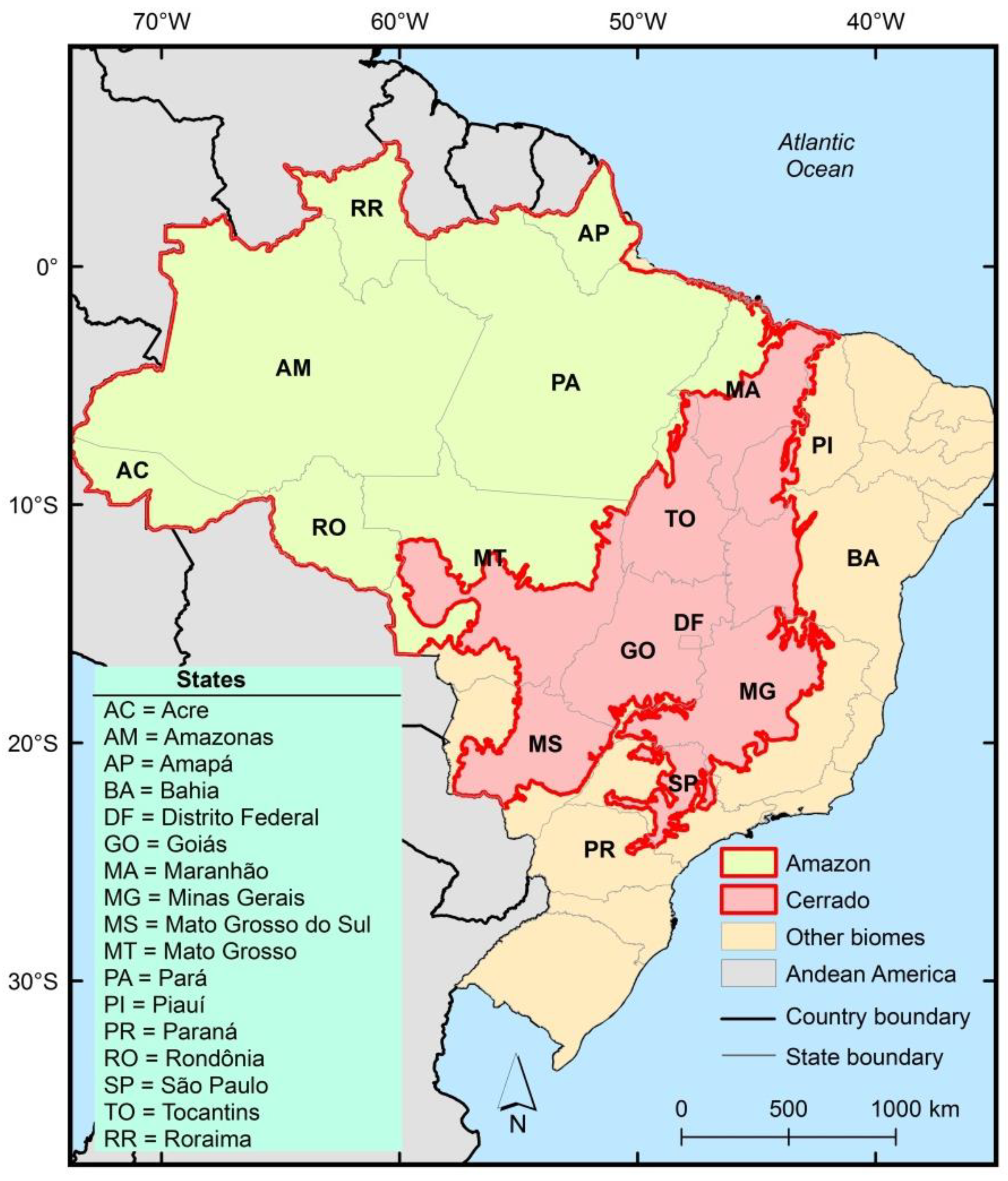
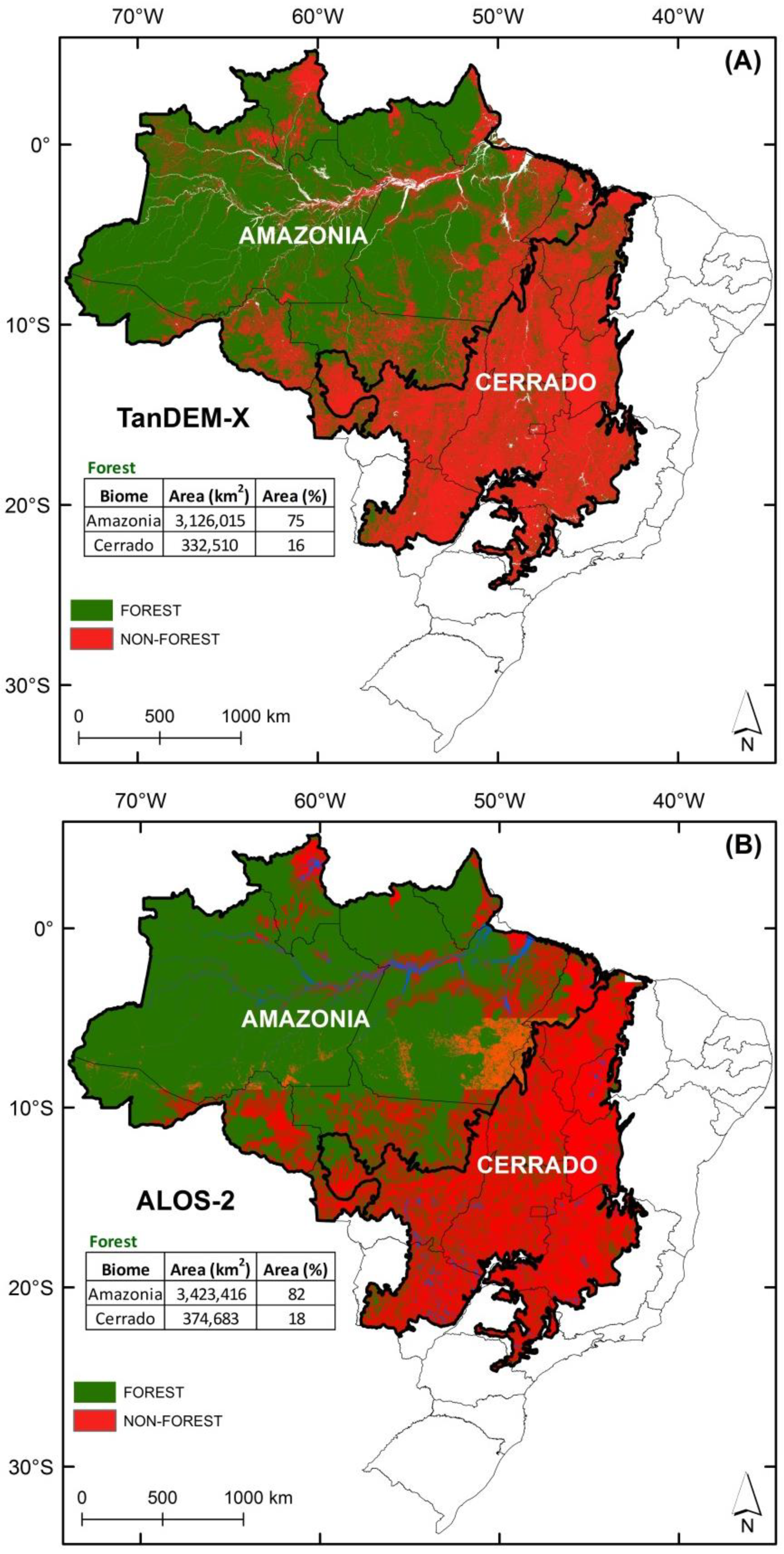
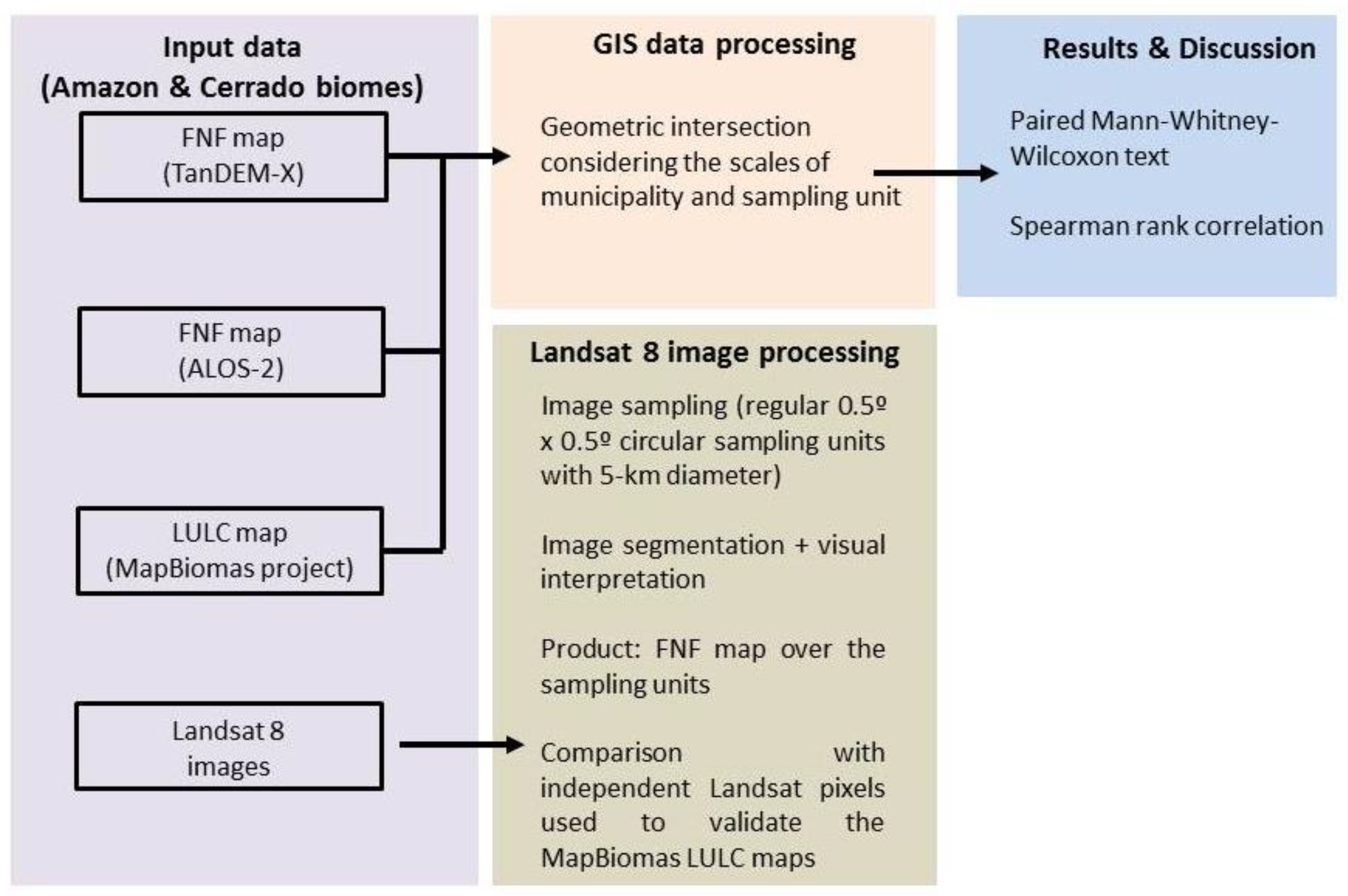
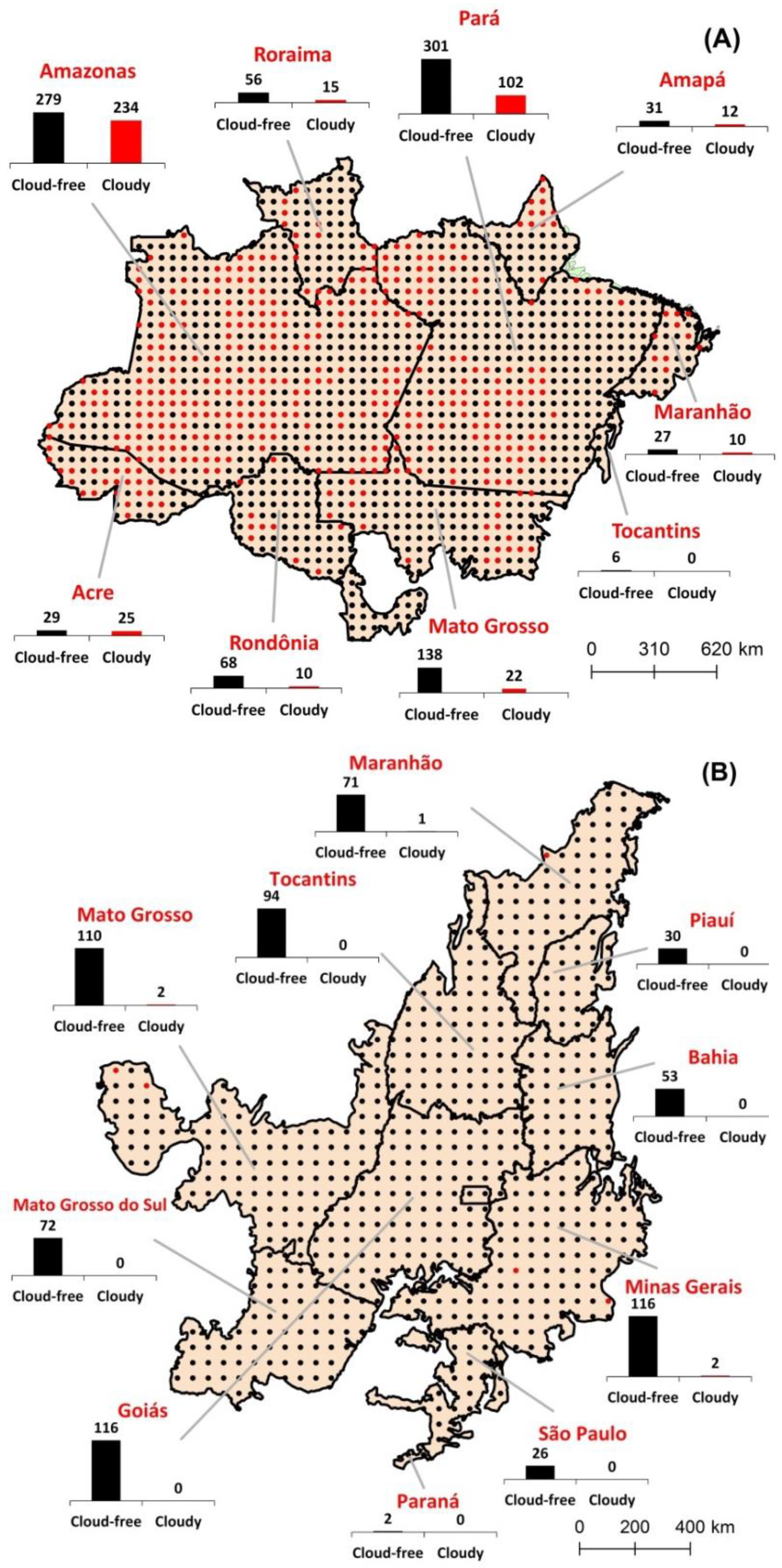

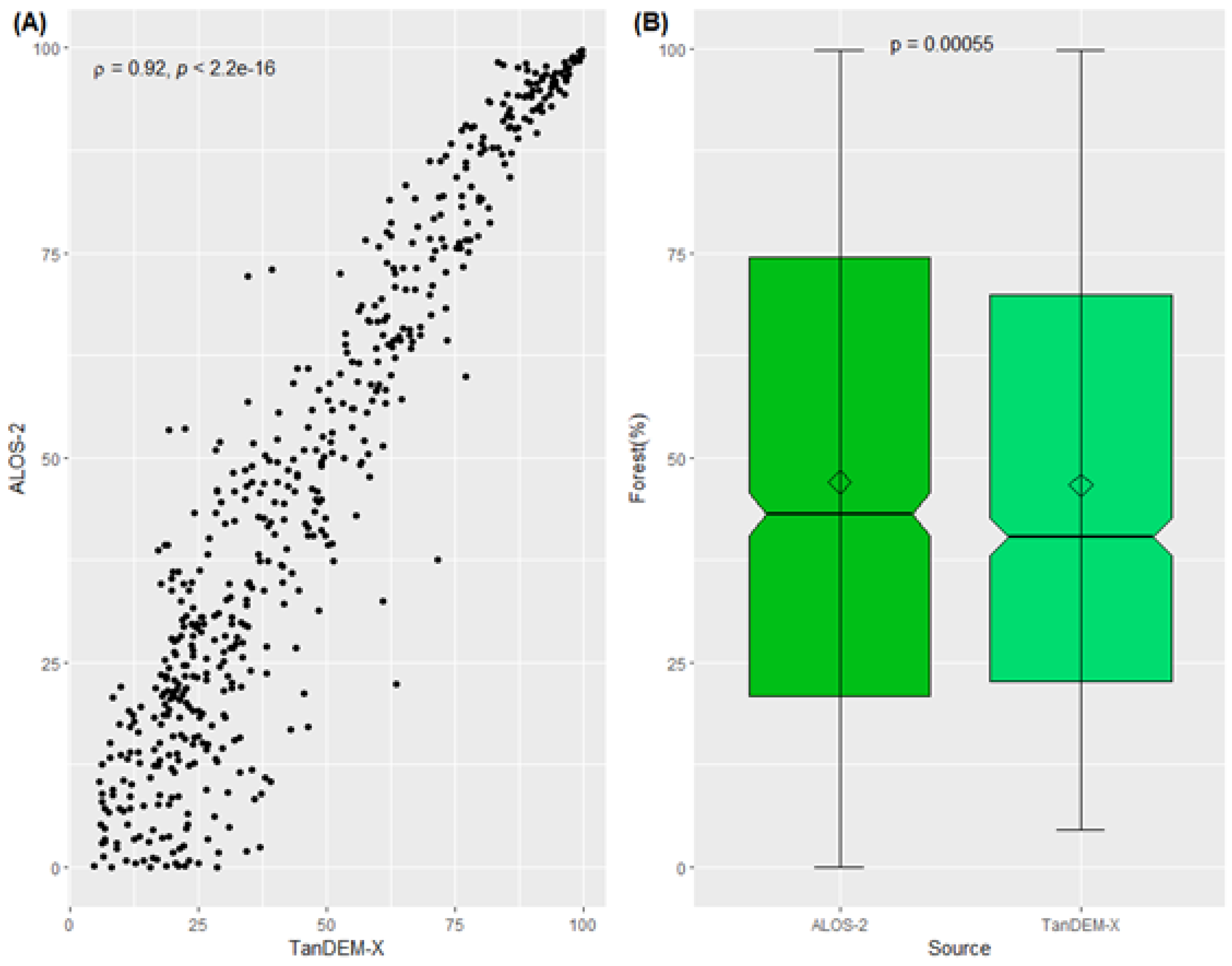
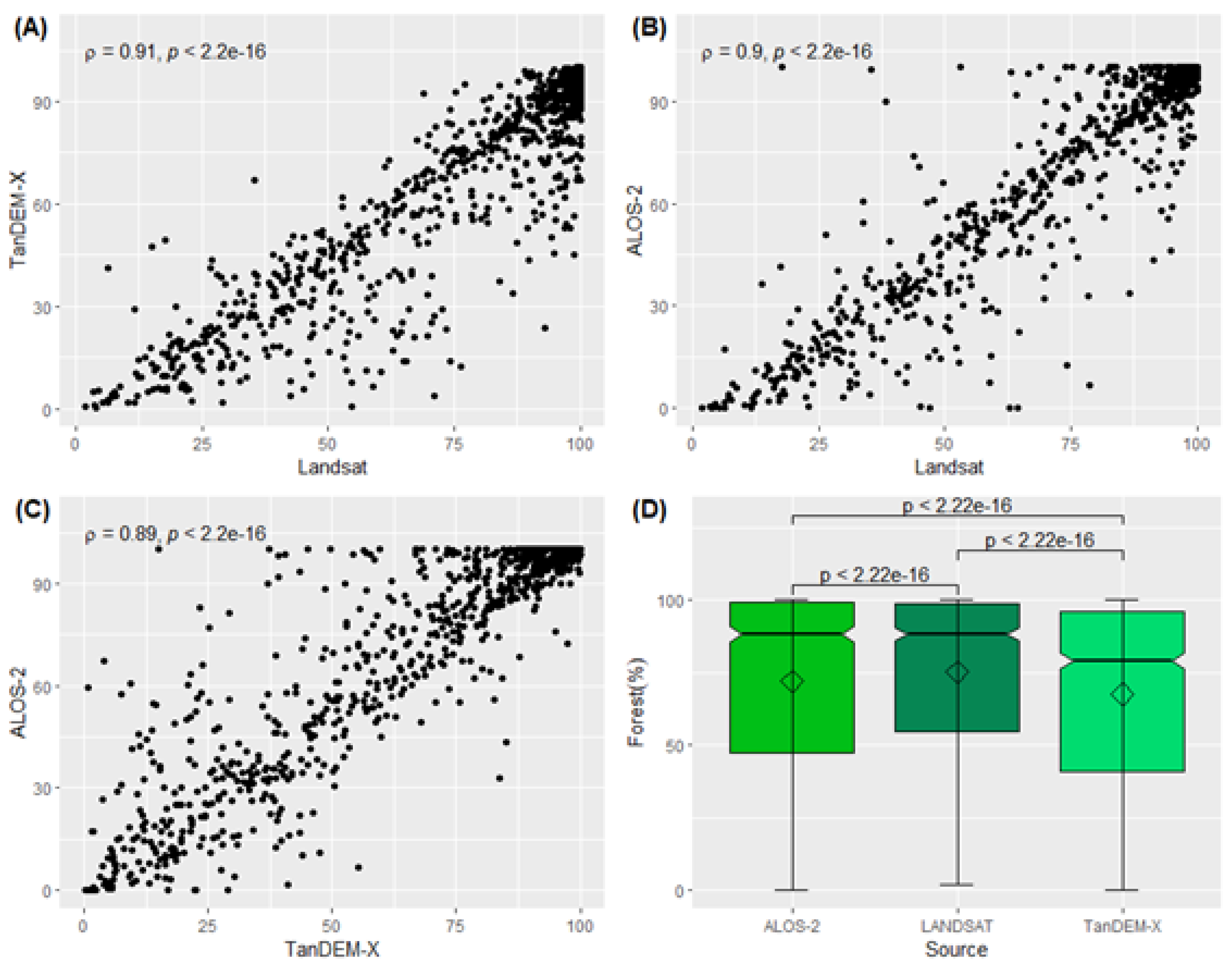
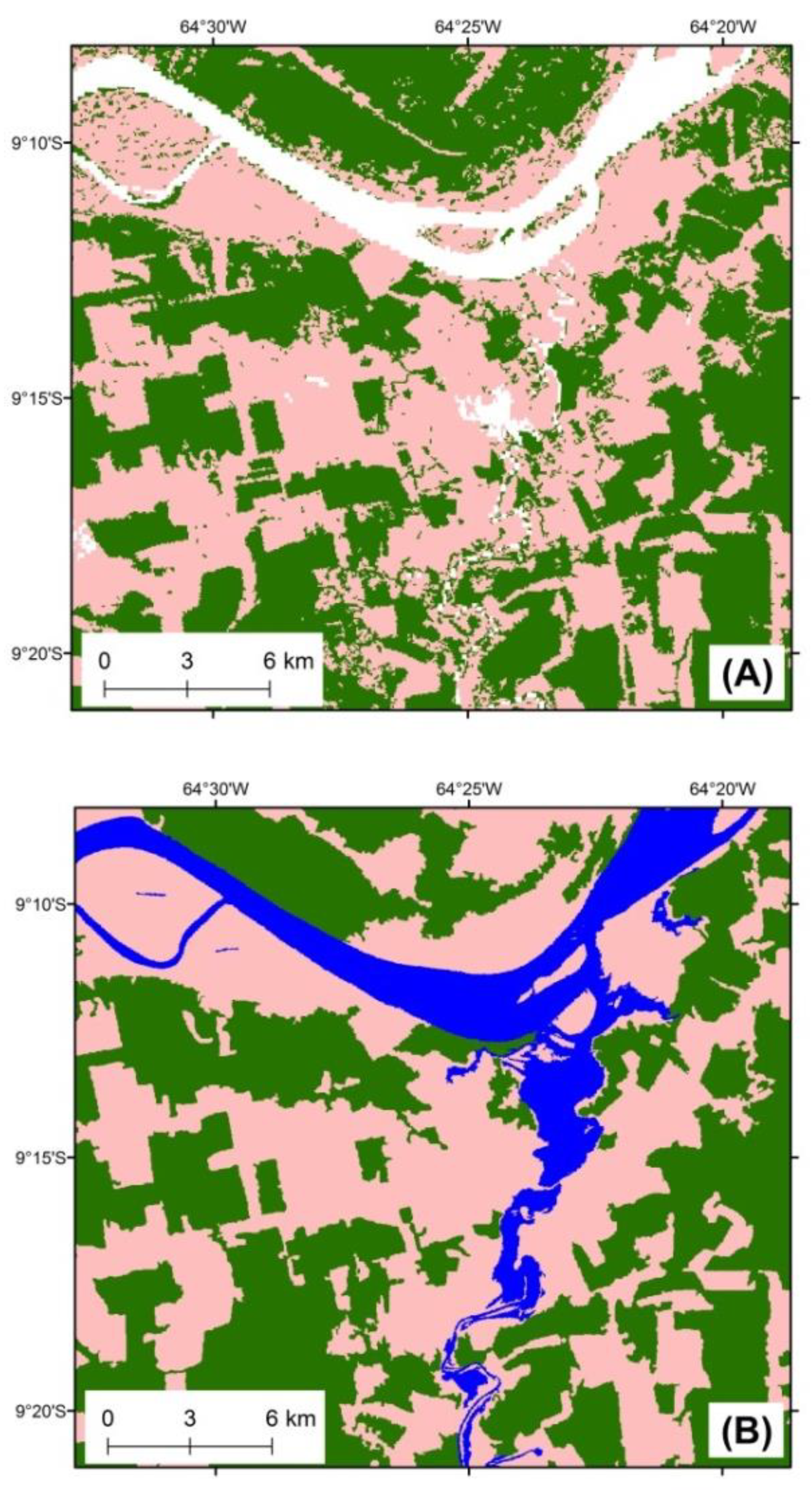
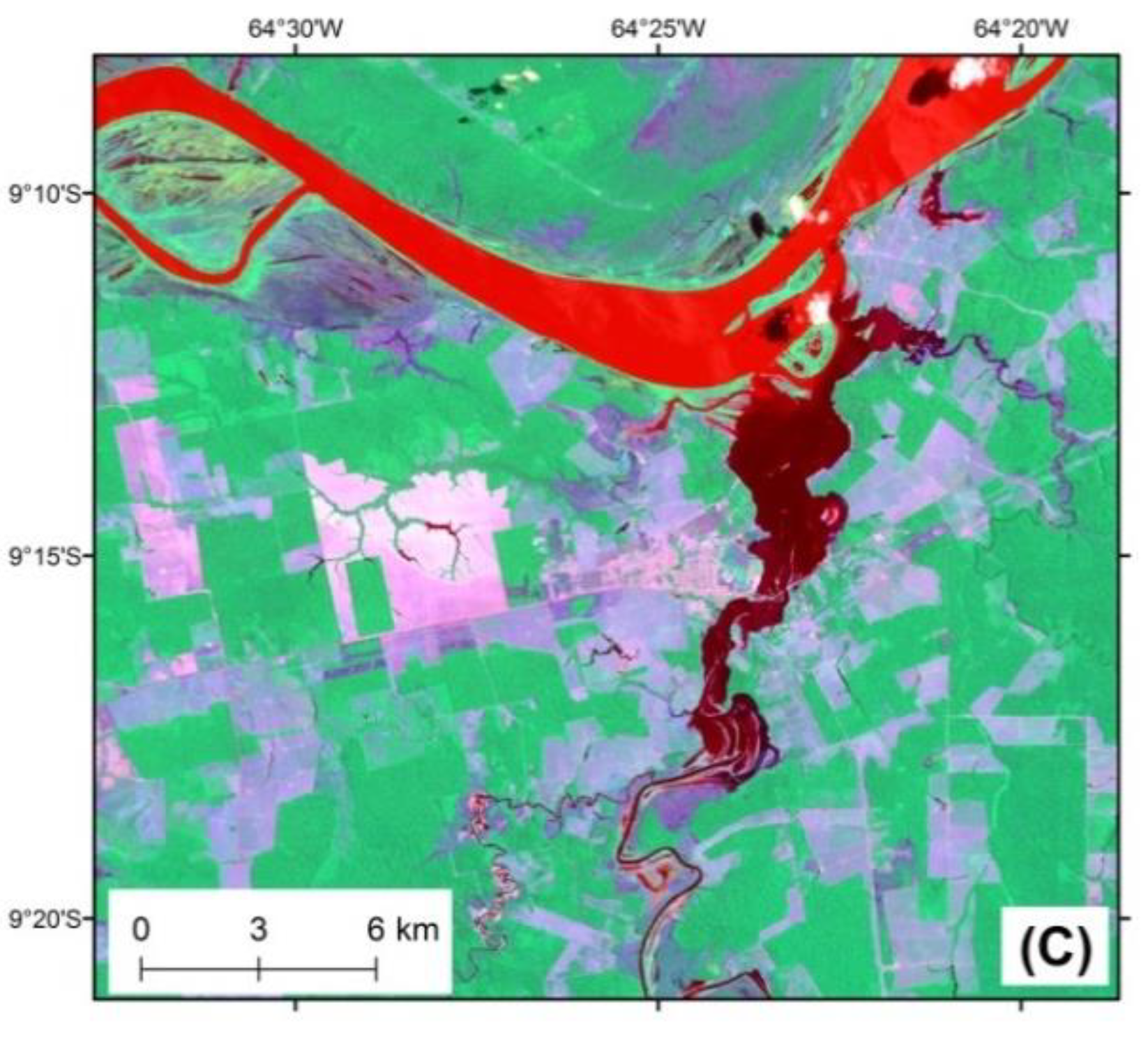
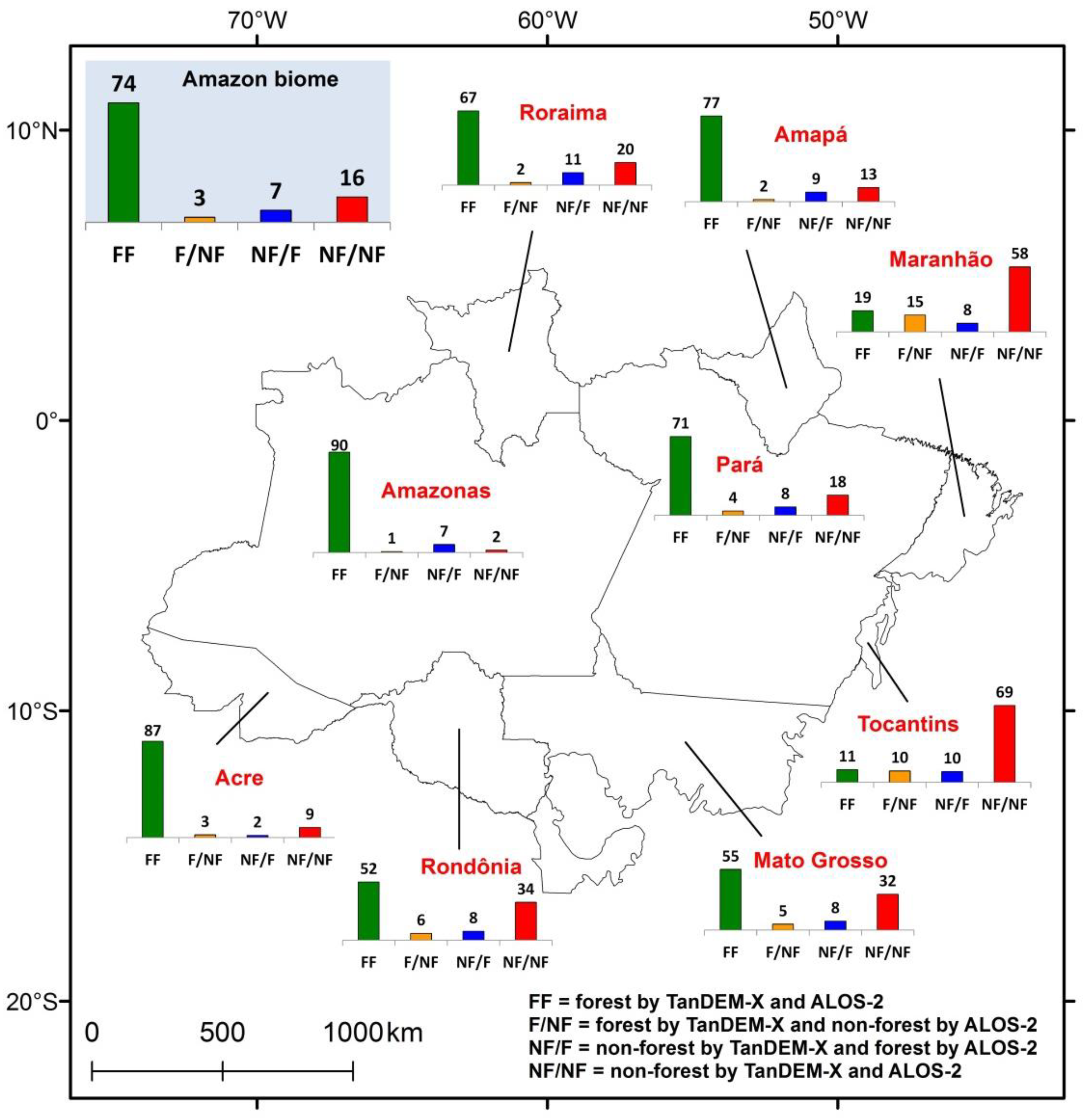
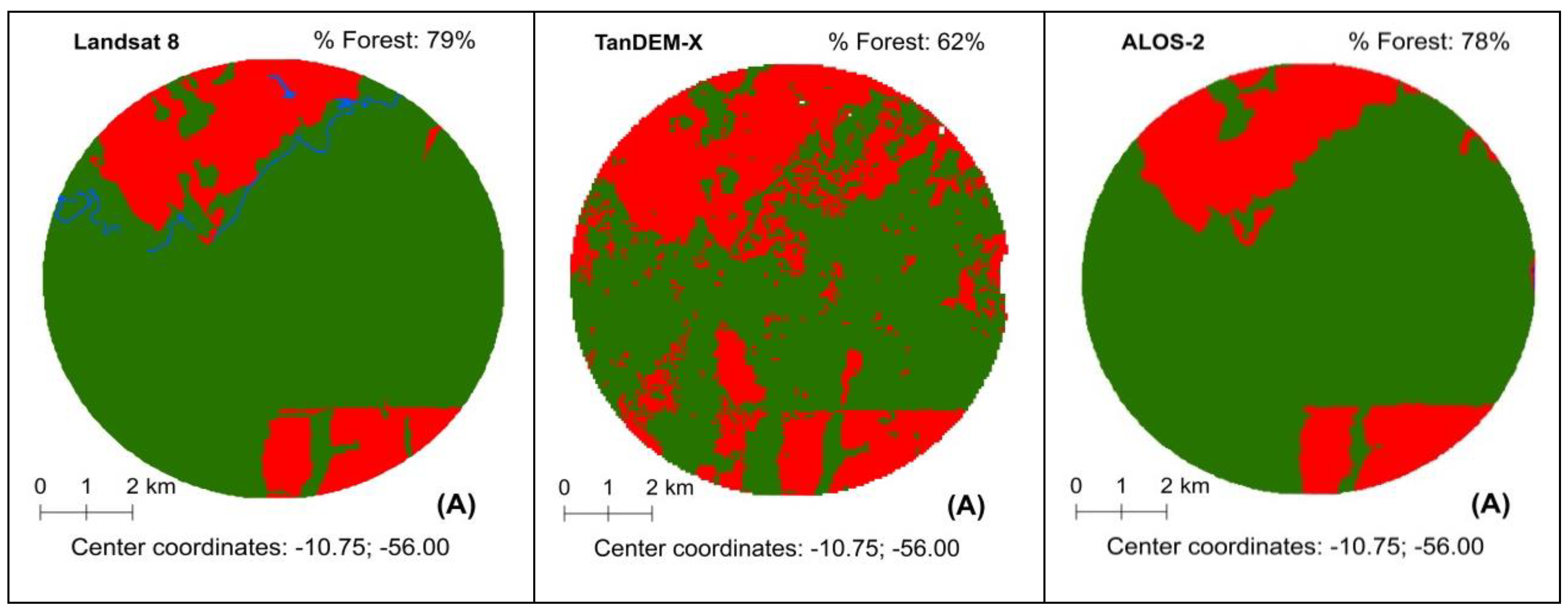
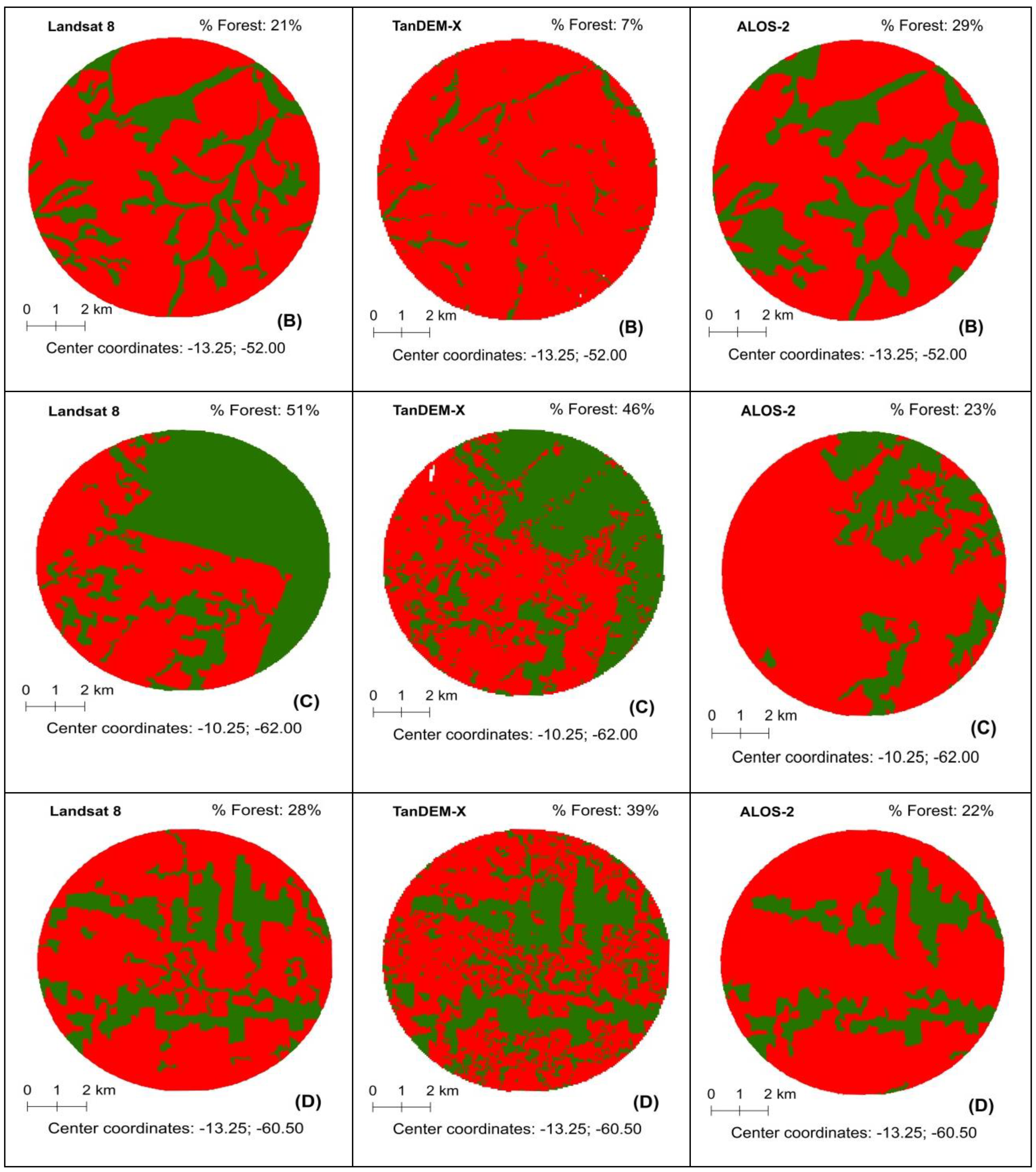
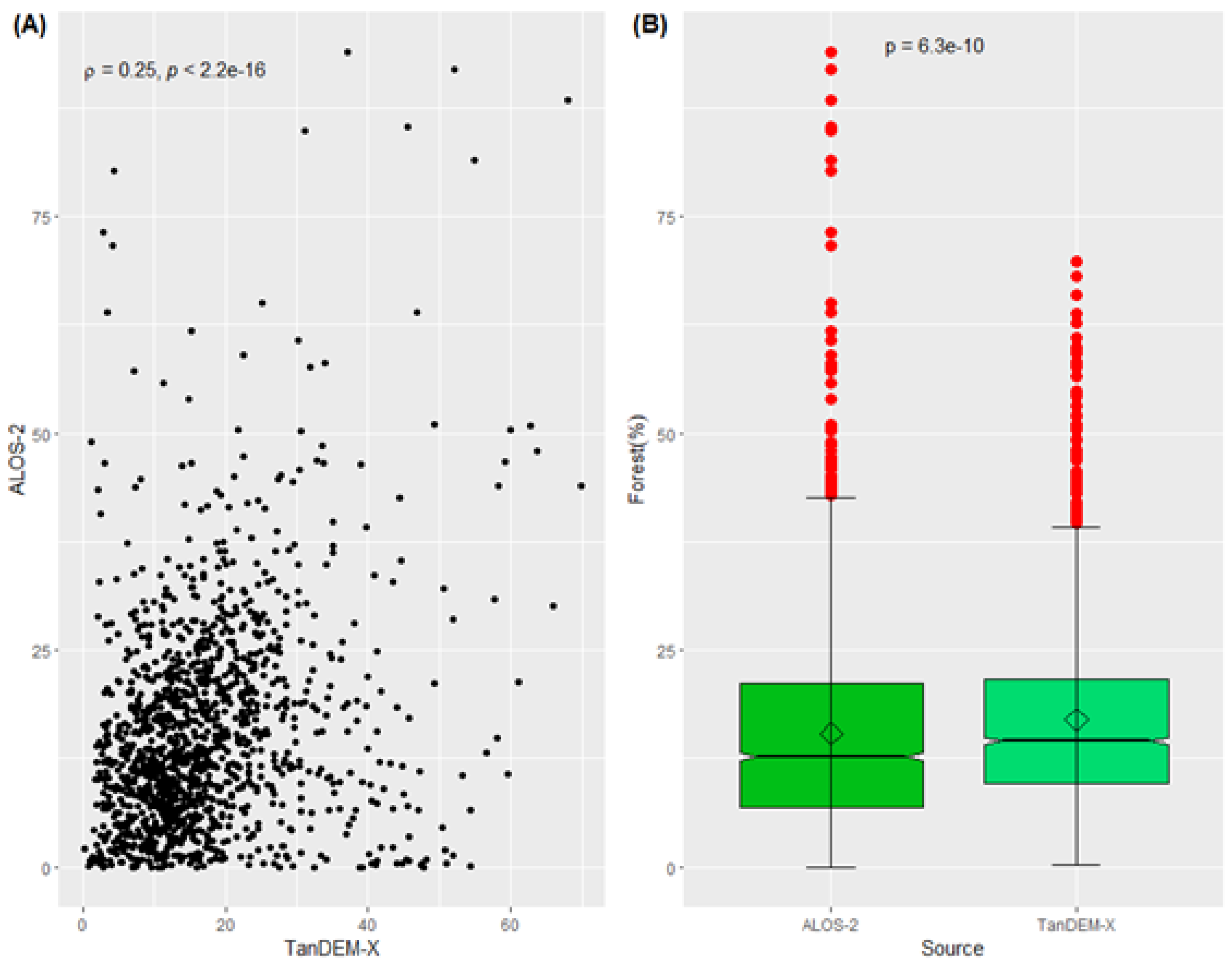
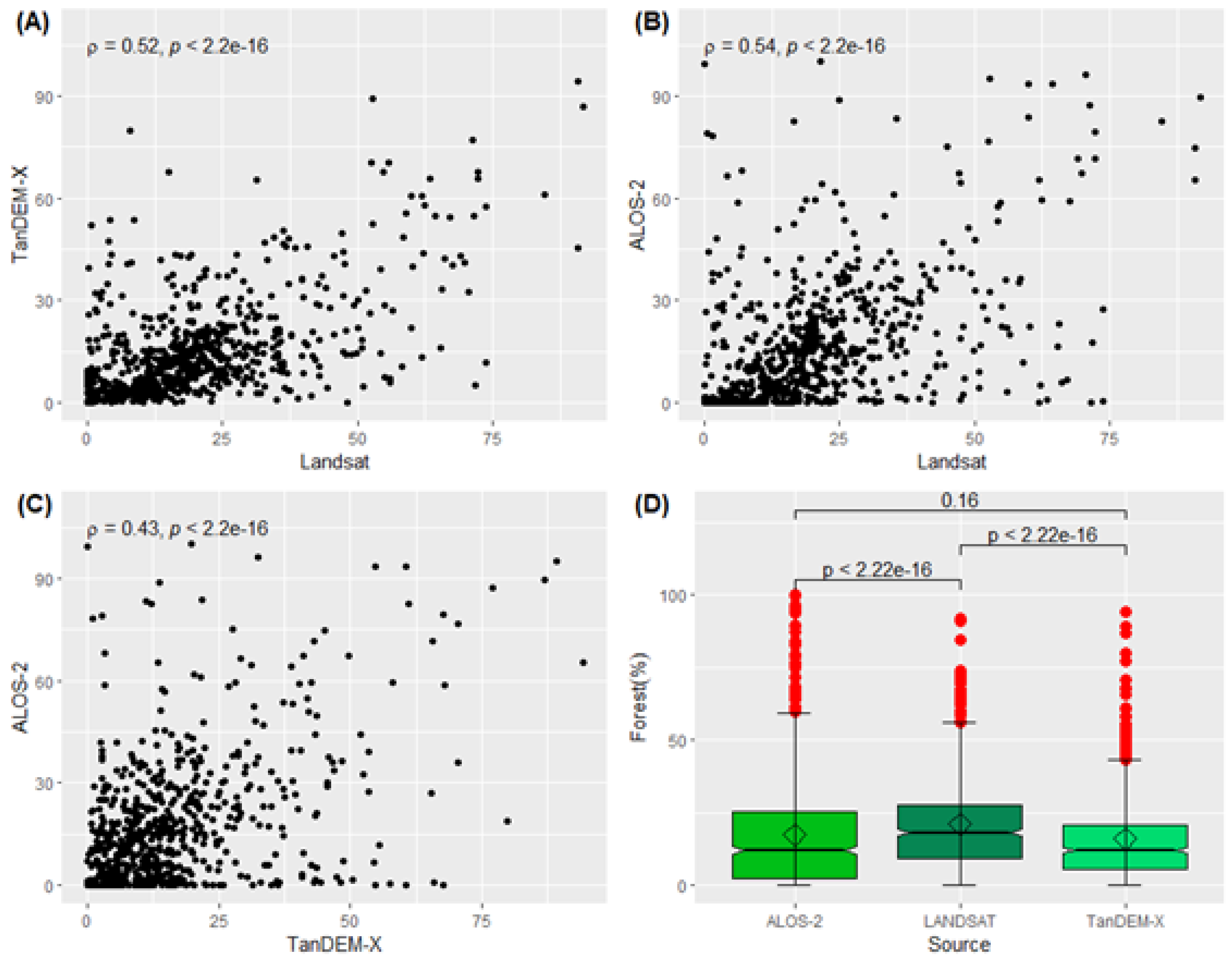
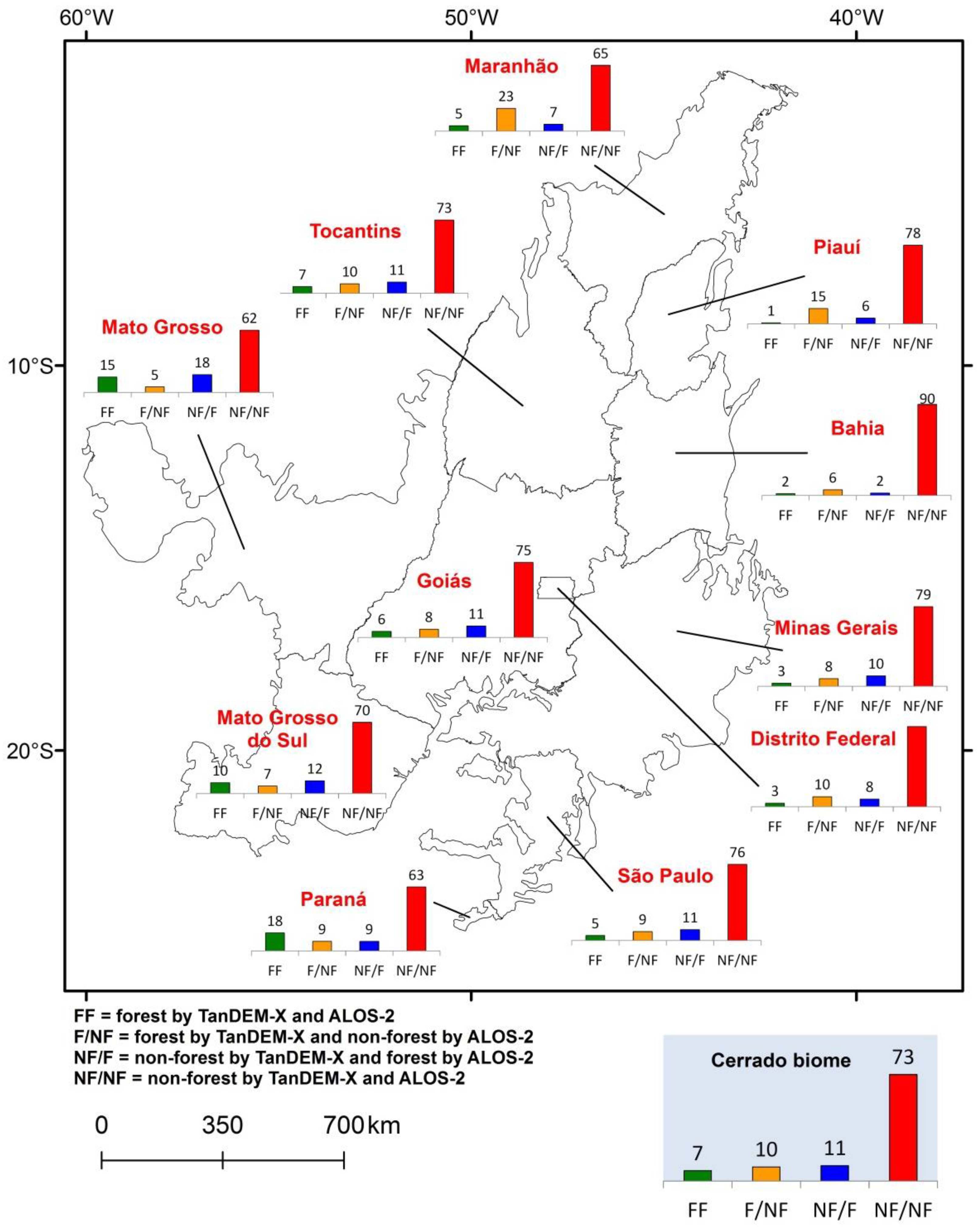
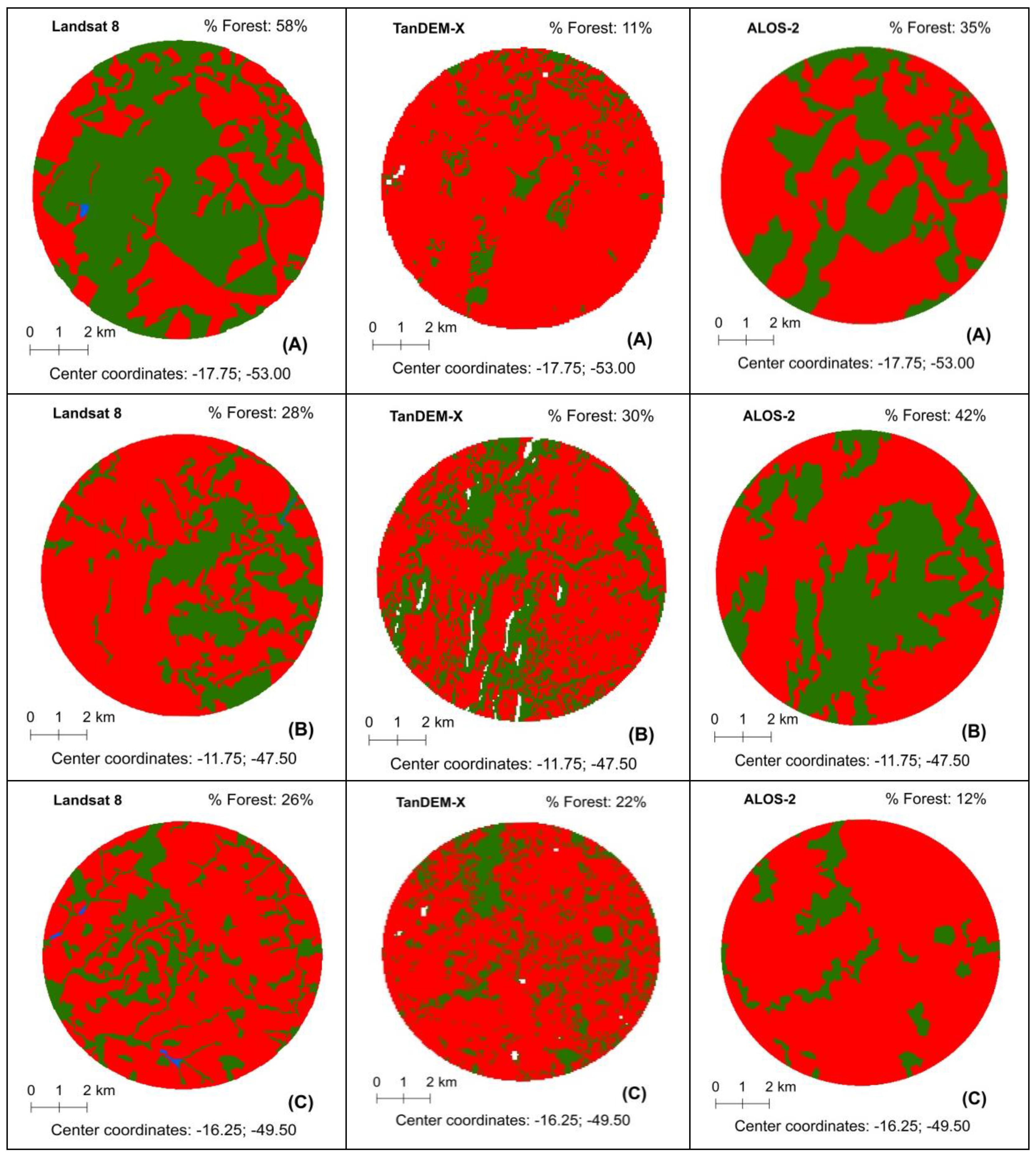
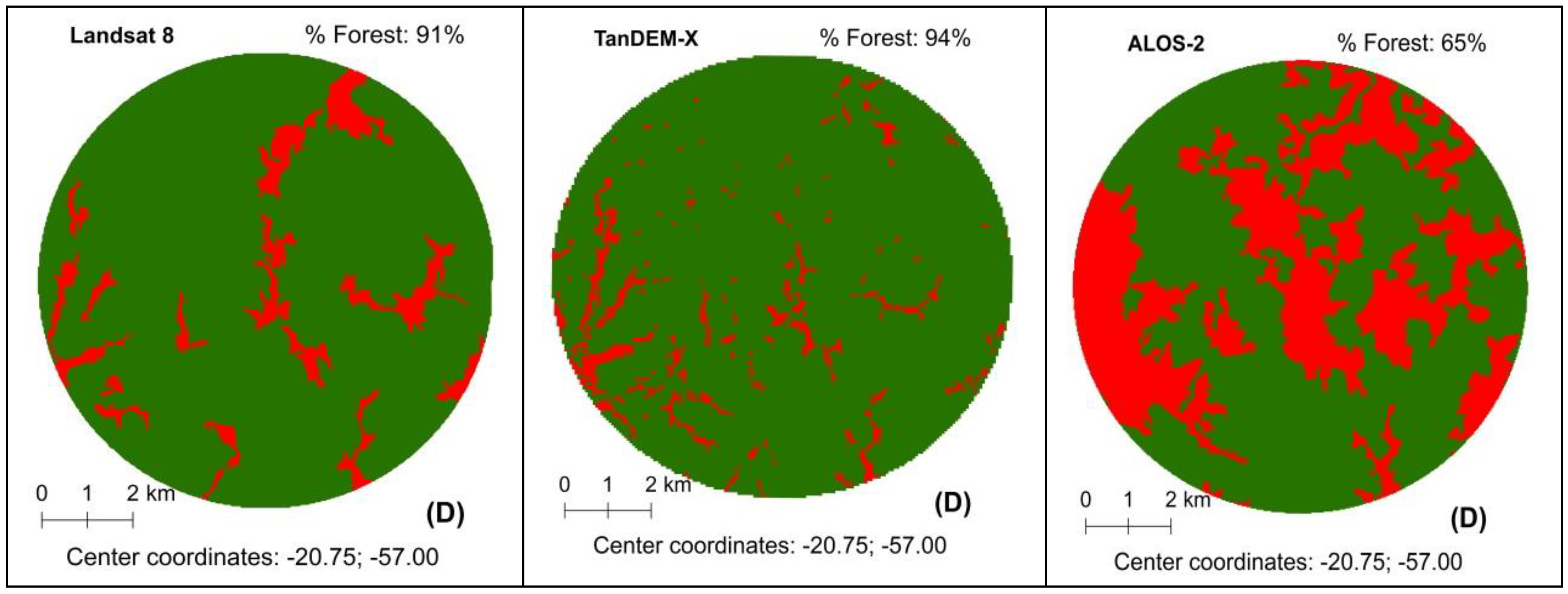
| LULC Class | Typical Interpretation Key | Biome | |
|---|---|---|---|
| Amazon | Cerrado | ||
| Forest | Color: dark green Texture: rough; intermediate Geometry: undefined | 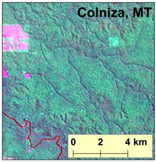 | 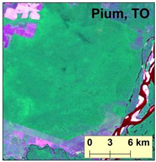 |
| Shrubland | Color: light green Texture: rough Geometry: undefined | 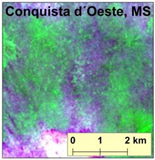 | 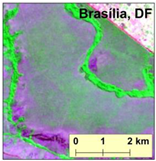 |
| Grassland | Color: pink; light pink Texture: smooth Geometry: undefined | 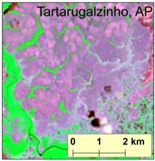 | 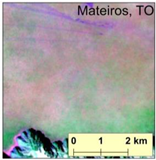 |
| Cropland | Color: pink; white Texture: smooth Geometry: regular |  | 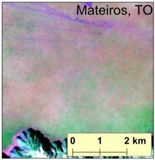 |
| Cultivated pastureland | Color: pink; light green Texture: smooth Geometry: regular | 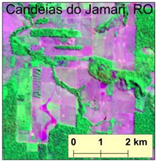 | 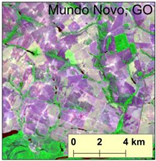 |
Publisher’s Note: MDPI stays neutral with regard to jurisdictional claims in published maps and institutional affiliations. |
© 2021 by the authors. Licensee MDPI, Basel, Switzerland. This article is an open access article distributed under the terms and conditions of the Creative Commons Attribution (CC BY) license (http://creativecommons.org/licenses/by/4.0/).
Share and Cite
Sano, E.E.; Rizzoli, P.; Koyama, C.N.; Watanabe, M.; Adami, M.; Shimabukuro, Y.E.; Bayma, G.; Freitas, D.M. Comparative Analysis of the Global Forest/Non-Forest Maps Derived from SAR and Optical Sensors. Case Studies from Brazilian Amazon and Cerrado Biomes. Remote Sens. 2021, 13, 367. https://doi.org/10.3390/rs13030367
Sano EE, Rizzoli P, Koyama CN, Watanabe M, Adami M, Shimabukuro YE, Bayma G, Freitas DM. Comparative Analysis of the Global Forest/Non-Forest Maps Derived from SAR and Optical Sensors. Case Studies from Brazilian Amazon and Cerrado Biomes. Remote Sensing. 2021; 13(3):367. https://doi.org/10.3390/rs13030367
Chicago/Turabian StyleSano, Edson E., Paola Rizzoli, Christian N. Koyama, Manabu Watanabe, Marcos Adami, Yosio E. Shimabukuro, Gustavo Bayma, and Daniel M. Freitas. 2021. "Comparative Analysis of the Global Forest/Non-Forest Maps Derived from SAR and Optical Sensors. Case Studies from Brazilian Amazon and Cerrado Biomes" Remote Sensing 13, no. 3: 367. https://doi.org/10.3390/rs13030367
APA StyleSano, E. E., Rizzoli, P., Koyama, C. N., Watanabe, M., Adami, M., Shimabukuro, Y. E., Bayma, G., & Freitas, D. M. (2021). Comparative Analysis of the Global Forest/Non-Forest Maps Derived from SAR and Optical Sensors. Case Studies from Brazilian Amazon and Cerrado Biomes. Remote Sensing, 13(3), 367. https://doi.org/10.3390/rs13030367









